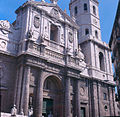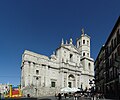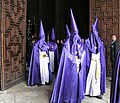Valladolid Cathedral: Difference between revisions
No edit summary |
|||
| Line 49: | Line 49: | ||
}} |
}} |
||
The '''Cathedral of Our Lady of the Holy Assumption''' ({{lang-es|Catedral de Nuestra Señora de la Asunción}}), better known as '''Valladolid Cathedral''', is a [[Roman Catholic]] [[cathedral]] in [[Valladolid]], [[Spain]]. It was designed by [[Juan de Herrera]]. |
The '''Cathedral of Our Lady of the Holy Assumption''' ({{lang-es|Catedral de Nuestra Señora de la Asunción}}), better known as '''Valladolid Cathedral''', is a [[Roman Catholic]] [[cathedral]] in [[Valladolid]], [[Spain]]. It was designed by [[Juan de Herrera]]. |
||
| ⚫ | |||
[[File:Valladolid museo catedral rincon claustro 20 maqueta sigloXVII lou.jpg|thumb|left|200px|Scale Model of the ideal project by [[Juan de Herrera]].]] |
[[File:Valladolid museo catedral rincon claustro 20 maqueta sigloXVII lou.jpg|thumb|left|200px|Scale Model of the ideal project by [[Juan de Herrera]].]] |
||
It would be the [[List of largest church buildings in the world|largest cathedral in Europe]], <ref>http://www.minube.com/rincon/catedral-de-valladolid-a4407</ref> although it is built over 40-45% from the original design,<ref>http://www.eldiadevalladolid.com/noticia.cfm/Vivir/20110808/joven/vallisoletano/dispuesto/culminar/proyecto/catedral/juan/herrera/7C079929-E789-B61B-BDF7D113EA2EBB41 "A Valladolidan young, ready to complete the project of Juan de Herrera's Cathedral", [[El Día de Valladolid|El Día de Valladolid (newspaper)]]</ref> due to lack of resources for a project of such magnitude and the expenses caused by the difficult foundations of the temple, located in an area with a large gap in the field. |
|||
| ⚫ | |||
[[File:Planta ideal Catedral Valladolid (España).JPG|thumb|left|200px|In black, what has been done; scratched, which has not been built; to points, the three apses that unimposing currently ships. Today is built over 40-45 %.]] |
[[File:Planta ideal Catedral Valladolid (España).JPG|thumb|left|200px|In black, what has been done; scratched, which has not been built; to points, the three apses that unimposing currently ships. Today is built over 40-45 %.]] |
||
[[File:Hb 56.234.jpg|thumb|left|200px|Gate of the cathedral, sold in 1956, which is currently in New York's [[Metropolitan Museum of Art]].]] |
[[File:Hb 56.234.jpg|thumb|left|200px|Gate of the cathedral, sold in 1956, which is currently in New York's [[Metropolitan Museum of Art]].]] |
||
| Line 98: | Line 99: | ||
Image:Interior de la capilla de San Lorenzo.JPG|Inside the chapel, part of the Diocesan Museum and Cathedral of Valladolid |
Image:Interior de la capilla de San Lorenzo.JPG|Inside the chapel, part of the Diocesan Museum and Cathedral of Valladolid |
||
</gallery> |
</gallery> |
||
==References== |
|||
{{reflist}} |
|||
{{Cathedrals in Spain}} |
{{Cathedrals in Spain}} |
||
Revision as of 04:23, 9 April 2016
| Cathedral of Our Lady of the Holy Assumption | |
|---|---|
 Main view of the Cathedral | |
| Religion | |
| Affiliation | Roman Catholic |
| District | Valladolid |
| Year consecrated | 1668 |
| Status | Active |
| Location | |
| Location | Valladolid, Province of Valladolid, Castile and León, Spain |
| Architecture | |
| Architect(s) | Juan de Herrera |
| Type | Cathedral |
| Style | Herrerian |
| Groundbreaking | 1589 |
| Direction of façade | Southeast |
| Official name: Catedral de Nuestra Señora de la Asunción de Valladolid | |
| Designated | 3 June 1931 |
| Reference no. | RI-51-0000980 |
| Website | |
| www | |
The Cathedral of Our Lady of the Holy Assumption (Spanish: Catedral de Nuestra Señora de la Asunción), better known as Valladolid Cathedral, is a Roman Catholic cathedral in Valladolid, Spain. It was designed by Juan de Herrera.

It would be the largest cathedral in Europe, [1] although it is built over 40-45% from the original design,[2] due to lack of resources for a project of such magnitude and the expenses caused by the difficult foundations of the temple, located in an area with a large gap in the field.
History




The cathedral has its origins in a late Gothic collegiate church, which was started during the late 15th century: before temporarily becoming capital of a united Spain, Valladolid was not a bishopric, and thus it lacked the right or necessity to build a cathedral. However, soon enough the Gothic collegiate church became outmoded with the growth of Renaissance classicizing architecture, and thanks to the newly established episcopal see, the Town Council decided to build a cathedral that would put similar constructions in neighbouring capitals in the shade.
The project as initiated would have resulted in one of the biggest cathedrals in Spain. When the construction was started, Valladolid was the de facto capital of Spain, housing king Philip II and his court. However, due to strategic and geopolitical reasons, by the 1560s the capital was moved to Madrid and funds for architectural projects were largely cut. Thus the cathedral was not finished according to Herrera's design; it was further modified during the 17th and 18th centuries, such as the addition to the top of the main façade, a work by Churriguera.
Description
The building, declared of Cultural Interest in 1931, is dedicated to Nuestra Señora de la Asunción. Although designed by Juan de Herrera, its construction was directed mainly by his disciples in the first half of the 17th century. Diego de Praves was the main contributor, and he was succeeded by his son. The design plan was a rectangle with two towers in the corners of the main façade, and another two finishing in pyramids, in the chancel.
The plan was a vast church with three aisles, with a transept on the centre, with two great doors in its ends. The main chapel and the choir were intended to be on the same place, facing the prayers (following the aims of the Council of Trent), so processions could pass round the back. Also, some chapels on the two sides of the building, placed between buttresses, were planned. Only a half of the church was built. Nowadays, the building stops at the transept. Only one tower now stands and it does not follow Herrera's plans.
The lower part of the main façade takes the form of triumphal arch in the Doric order Due to an error in construction the portal arch is rather pointed.
In the 18th century Alberto Churriguera erected the second part in imitation of the façade of the church of El Escorial. Capping the balustrade are statues of St. Ambrose, St. Augustine, St. Gregory and St. Jerome. Then the tower on the side of the vestry was erected which, after suffering damage in consequence of the Lisbon earthquake (1753), finally fell down in 1841; it was re-erected next to the vestry and is crowned with a statue of the Corazón de Jesús (Sacred Heart).
Today it contains a rich musical archive housing 6000 works, and a 16th-century altarpiece by Juan de Juni taken from the church of Santa María La Antigua, also in Valladolid, while the altarpiece by El Greco originally in the cathedral, has been moved elsewhere.
There are four chapels on either side of the church. In the first there is a Neoclassical picture of Cain and Abel and the second was property of Juan Velerde. The third has two late 17th century large pictures, work of a follower of Lucas Jordan. The next is dedicated to San Fernando and the tomb of Count Ansúrez is close to it, whose statue dates from the 16th century.
The main chapel has the altarpiece made by Juan de Juni was transferred to its present position in 1922. The choir stalls were built by Francisco Velázquez and Melchor de Beya in 1617 and them came from the convent of San Pablo, in Valladolid. In the other side of the church, on the third chapel there is a Baroque altarpiece of the 18th century and a group of statues and funerary reliefs of the Venero family, work of a disciple of Pompeo Leoni. The second chapel has a Baroque altarpiece, with a sculpture of San Pedro, by Pedro de Ávila and a 16th-century screen.
The great pipe organ, over the main door, was built in 1904 by Aquilino Amezua and enlarged in 1933 by his former partner L. Galdós using a classicist case from a previous organ, built in 1794. It follows romantic taste and has three manuals and pedal, with 36 stops. There is also an Allen electronic-digital organ.
In the vestry there are several pictures: for example, an Assumption of the second quarter of the 17th century by Diego Valentín Díaz and a San Jerónimo y San Jenaro by Lucas Jordan.
Gallery
-
view from Plaza Mayor
-
from Regalado Street
-
Main view
-
inside
-
roof
-
Statue of the Sacred Heart
-
in 1920s
-
in 1960s
-
also in 1960s
-
in 1990s
-
2012
-
Members of brotherhoods during Holy Week in Valladolid
-
Inside the chapel, part of the Diocesan Museum and Cathedral of Valladolid
References
- ^ http://www.minube.com/rincon/catedral-de-valladolid-a4407
- ^ http://www.eldiadevalladolid.com/noticia.cfm/Vivir/20110808/joven/vallisoletano/dispuesto/culminar/proyecto/catedral/juan/herrera/7C079929-E789-B61B-BDF7D113EA2EBB41 "A Valladolidan young, ready to complete the project of Juan de Herrera's Cathedral", El Día de Valladolid (newspaper)














